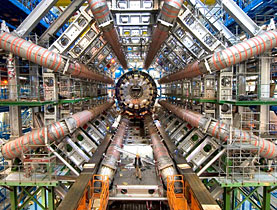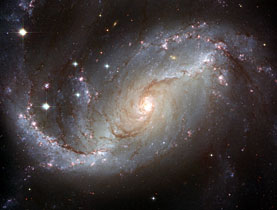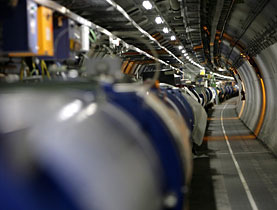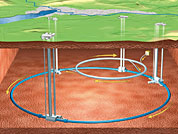Collider “not going to become a white elephant”

September should have been a happy first anniversary for the physicists pulling subatomic secrets out of the Large Hadron Collider.
They have spent much of the past year repairing it instead. Buried on the outskirts of Geneva beneath Swiss and French soil rests the world’s largest soon-to-be-working particle accelerator.
On Friday, the European Organization for Nuclear Research (Cern), the group that developed the LHC, said the repairs cost nearly SFr35 million ($34 million).
The machine, the most powerful of its kind, was designed to recreate the conditions of the universe at its earliest, most violent stage of infancy.
When it was inaugurated, its champions had hoped it would help them explain the origins of everything. So far, its functional life has been much like the matter it zips around: quick. Barely a week after it first beamed particles, the LHC broke down.
That left thousands of scientists around the world, who were waiting for reams of data the LHC was supposed to fire off, in a lurch.
“Of course everyone was very disappointed,” said Edda Gschwendtner, an experimental physicist at Cern. “Everyone was eager to take data.”
Cern expects to turn on the switch for the second time within the next two months but with some caution. The LHC, for the time being, will operate at 3.5 trillion electron volts (TeV), half the power it ought to be capable of.
“It’s not going to become a white elephant,” spokesman James Gillies told swissinfo.ch.
Disappointed
“People are looking forward to November,” Gillies said. He admits that expectations last year were high. “It was huge. Everybody was waiting for it.”
Gschwendtner and others make the point that the LHC is both prototype and final product. She said, “This is really a flagship. There has never been an accelerator of this kind before.”
The consensus around the group’s university-like campus near Geneva is that the particle accelerator will function at its full capacity – in due course.
“Well, I’m sure that things will work smoothly eventually,” said Werner Riegler. “If it’s in November is hard to tell. If you look at all of the components that have to work together – and each single one has to work – it’s clear it takes some time to get it going.”
Riegler is technical coordinator for the Alice detector, which comprises hundreds of millions of sensors and is anchored to the bottom of a humongous concrete-encased hole in the ground.
Meant to collect data from particle collisions, Alice is one of four house-sized detectors and is as big as it is byzantine. It is 20 metres long and 20 metres in diameter.
Big Bang, big machine
“You have a collaboration of between 1,000 and 2,000 people,” Riegler said. “All these technologies and detectors are just built for this application. This is nothing you can buy off the shelf.”
At its full strength of 7 TeV, the LHC dwarfs the world’s second-largest accelerator, the 40-year-old Tevatron, located at Fermilab, outside Chicago. It operates at 1 TeV.
To transfer power to the more than 1,000 magnets around the LHC’s ring, copper-encased niobium-titanium wires are cooled with liquid helium to temperatures barely above absolute zero. At normal temperatures, they would be incapable of handling the current.
“Every new frontier machine is not just pushing the frontiers of knowledge but also the frontiers of technology,” Gillies said.
But keeping a 27-kilometre tube insulated to a temperature colder than deep space isn’t simple and when the liquid helium leaked shortly after the launch, Cern had to deinstall 53 magnets.
Each is more than ten metres long and has a unique spot along the ring; and each was raised above ground for cleaning.
Keep your head up
“What happens is that you pick yourself up, figure out what needs to be done and that’s what the people here have been doing,” Gillies, a former physicist, said.
What the LHC has accomplished so far is to further push interest in nuclear physics outside the realm of geekdom. Cern has figured in popular culture thanks to United States author Dan Brown and around this time last year, Gillies’ quotes peppered the pages of the world’s major newspapers and magazines.
Cern’s press office says it has received about 800 visits from journalists over the past year – twice as many as usual.
Several people were concerned the LHC would create a black hole that would destroy the planet. A lawsuit in Hawaii was unsuccessful.
Gillies, affable and articulate, takes the challenges in his stride. Cern’s first particle accelerator, the Proton Synchrotron, is still operating after 50 years, he notes.
The physicists have so far assuaged themselves by studying cosmic rays and are busy with preparations for the relaunch. Said Riegler: “At this moment, the pressure is really on the people who built this accelerator.”
Justin Häne on the border of Switzerland and France, swissinfo.ch
In the LHC, high-energy protons in two counter-rotating beams will be smashed together to search for exotic particles.
Each beam contains billions of protons. Travelling just under the speed of light, they are guided by thousands of superconducting magnets.
The particles pass through four pre-accelerators before entering the LHC.
The beams collide in the hearts of the main experiments, known by their acronyms: Alice, Atlas, CMS, and LHCb.
The detectors could see up to 600 million collision events per second, with the experiments scouring the data for signs of extremely rare events such as the creation of the still theoretical Higgs Boson particle.
Physicists believe that if the Higgs Boson does exist, the best chance of finding it will be with a detector of the HLC’s power.
The LHC tunnel is 27km long and runs between Lake Geneva and the Jura mountain range. When it was excavated, its two ends met up within 1cm.
Cables for the LHC contain 6,300 superconducting filaments of niobium-titanium that are 0.006mm thick. In total, they stretch more than 10 times the Earth’s distance to the sun.
The LHC contains the world’s largest fridge. Its temperature is nearly absolute zero, colder than deep space.
The LHC’s two proton beams will use as much energy as a 400-ton train travelling at 200 km/h. Each particle contains the energy of one mosquito.
The system’s magnet contains more iron than the Eiffel Tower.
Cern was founded in 1954 by 12 states including Switzerland and now has 20 member states. One of its scientists invented the internet.

In compliance with the JTI standards
More: SWI swissinfo.ch certified by the Journalism Trust Initiative















You can find an overview of ongoing debates with our journalists here . Please join us!
If you want to start a conversation about a topic raised in this article or want to report factual errors, email us at english@swissinfo.ch.